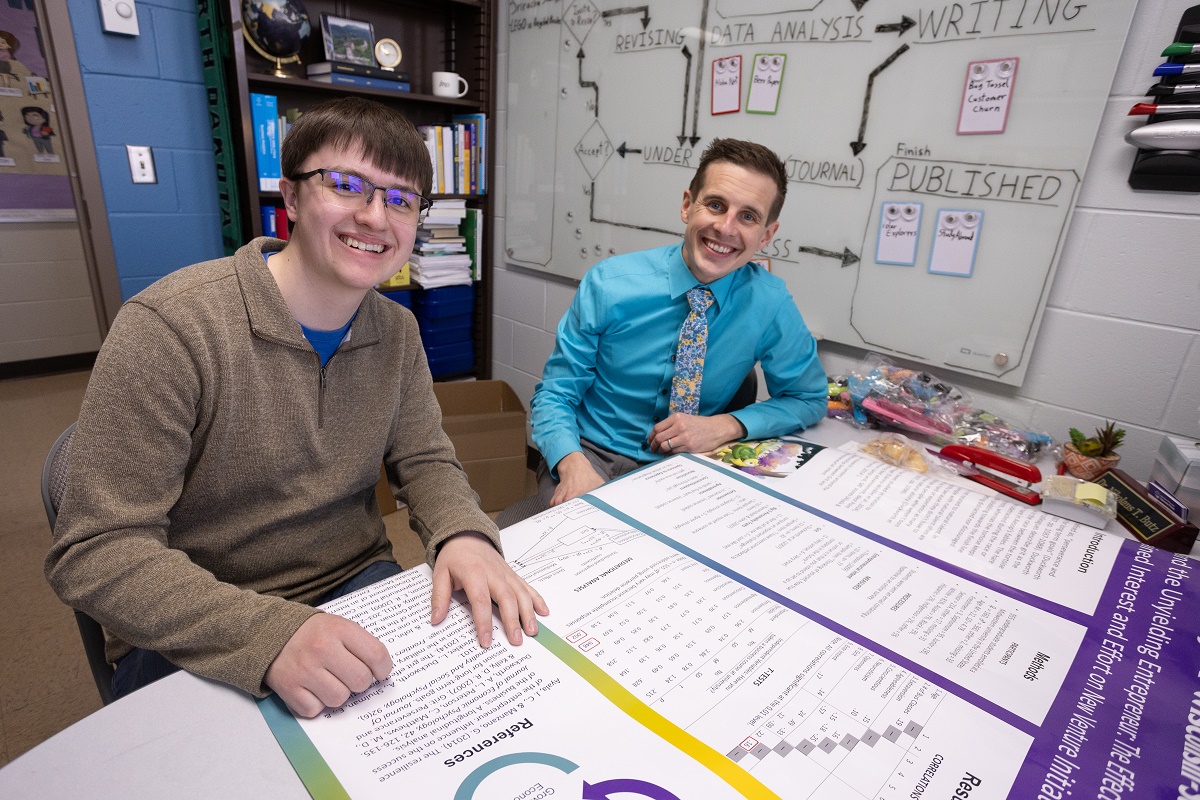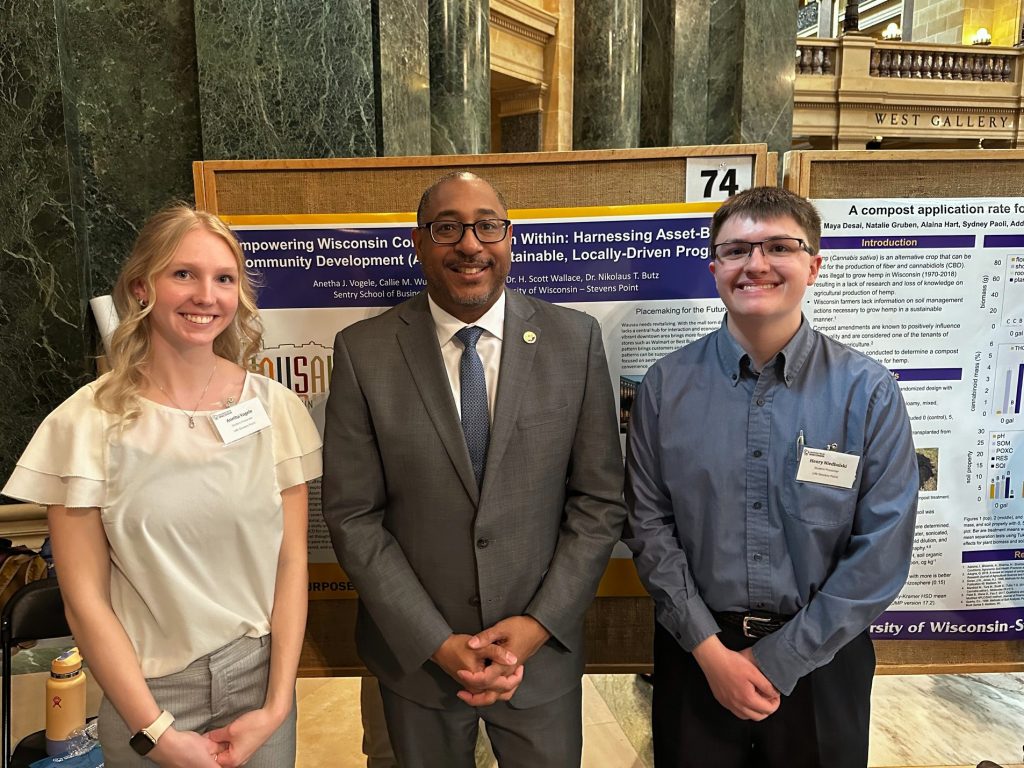
A recent legislation will require financial literacy education courses in Wisconsin high schools starting the fall of 2024. In response, University of Wisconsin-Stevens Point junior Henry Niedbalski will present his investigations on the current state of financial literacy education in schools at the 20th anniversary Research in the Rotunda event on Wednesday, March 6. [Event Photos]

Held at the Wisconsin State Capitol, the annual event invites undergraduates from across the Universities of Wisconsin to exhibit their research. Niedbalski will be among the 29 students and faculty representing UW-Stevens Point in showcasing their work in front of Wisconsin’s legislators, state leaders and university peers.
Niedbalski, a finance major from Wisconsin Rapids, found that while state legislature action will be helpful at the high school level, his research hopes to give data points where students/educators can improve inadequate areas of financial literacy. He collaborated on his research with UW-Stevens Point’s Sentry Insurance Endowed Chair of Business Analytics Professor Nik Butz.
Butz said he was impressed by Niedbalski’s work ethic and can-do attitude. Niedbalski has worked under Butz for more than a year. His work began by scanning newspapers for data and analytics articles for Butz and now he works as his professor’s assistant, performing data cleaning, survey creation and curation of readings for a business analytics class.
During his initial research, Niedbalski found only 35 percent of Wisconsin high schools require financial literacy courses. The data he is collecting will measure the discrepancies between how prepared students feel on financial topics versus how they rank their respective importance. Measured data points include topics such as saving, investing, budgeting and understanding taxes.
The Financial Industry Regulatory Authority found that financial literacy is strongly correlated with higher savings among individuals.
Niedbalski said financial literacy also benefits society, as it strengthens an individual’s ability to make more sound financial decisions. At present, there are gaps in financial literacy education that may rest on universities to fill, he said.
Some UW System schools, including UW-Stevens Point, offer financial literacy certificates and student organizations to help close the gap for students who may have not received these education courses previously. “Our research also raises the question of how this gap will be filled for those who do not choose a university path prior to the date mandated,” said Niedbalski.
Estimated costs of those lacking knowledge total around $2,000 annually, according to The National Financial Educators Council.
“We are at a critical phase where responsibility for training young people in financial literacy is shifting,” Niedbalski said. “In terms of implementation, our research highlights opportunities to make the most impact contributions to refining and improving financial literacy education at the secondary and post-secondary level.”
Niedbalski will attend Research in the Rotunda for the first time, however, he will be in experienced company with Butz, who has brought students to Research in the Rotunda since 2017.
Butz said this offers a great experience for students to make possible connections and get inspiration from other Universities of Wisconsin students and representatives in attendance. He added that the event empowers students by granting them the support and recognition they deserve.
While their research is still in progress, Niedbalski and Butz figure their call to action may lead to determining whether financial literacy education should be required on UWSP’s campus as well.
Niedbalski chose this topic as it is something he is passionate about. He believes financial literacy education is a subject which benefits everyone. The opportunity to share research with policymakers in the state is something to look forward to, he said.
“Henry has a strong work ethic, and even if he doesn’t know how to do something, he isn’t afraid to ask for help and to give it his best effort. That will take him far in research and life,’ said Butz.
Niedbalski will spend this summer interning with Church Mutual Insurance’s underwriting department.
UW-Stevens Point students presenting research at the capitol
In addition to Niedbalski, sixteen additional students across six projects are presenting as part of Research in the Rotunda, including:
- “A Compost Application Rate for Sustainable Hemp Agriculture in Wisconsin” by Natalie Gruben, Alaina Hart, Maya Desai, Addison Pfeil, Rosalind Remsen, Sydney Paoli and Gregor Willms
The group conducted tests to determine if compost would improve soil quality and health of hemp plants to gain information to pass on to Wisconsin farmers that want to grow hemp in a sustainable manner. - “Adsorption of PFAS in Nanoporous Solids” by Olivia Stelpflug, Jackson Mikel and Anna Hahn
The group explored a potential avenue to combat PFAS through the combination of adsorption and nanoporous solids that could be deployed for the removal of PFAS in water. - “Empowering Wisconsin Communities From Within: Harnessing Asset-Based Community Development (ABCD) for Sustainable, Locally Driven Progress” by Anetha Vogele
Vogele examined how Asset-Based Community Development can be used to leverage certain principle topics to better achieve sustainable, locally-driven progress within Wisconsin communities. - “Gold Mountain in the Pinery: Chinese Americans in Rural Wisconsin, 1875-1940” by Jarita Bavido
Bavido’s research considers the motivations for early Chinese American immigration to the Midwest in the late 1800s. Using newspaper, census, and archival data, the results show the economic presence and persistence of Chinese people in more than 55 counties in Wisconsin in an era when the immigration of Polish, German, and Scandinavian people has been more fully researched and is more well known. - “How Certain Genes in the Stewart’s Wilt Causal Pathogen Pantoea stewartii Affect the Pathogen Spread and Biofilm Formation in Sweet Corn” by Kade Fink
Fink studied the use of two mutants of a wild-type Ps strain and how it may affect stewart’s wilt, a bacterial pathogen posing a potential threat to the U.S. corn industry. His results concluded the genes may facilitate the pathogen’s spread and biofilm production in sweet corn plants, which is essential information in understanding and contributing to the analysis of the Stewart’s wilt susceptibility mechanism of corns and other host species. - “Preliminary Results for Quantifying Ectoparasite Diversity and Prevalence in Northern Sawwhet Owls (Aegolius acadicus) in Central Wisconsin” by Sophie Reid, Sophie Hauser and Dana Lotz
The group investigated relationships between ectoparasites and the Northern Saw-whet Owl (NWSO) to determine possible differences in ectoparasite prevalence based on their age categories. Fieldwork was conducted to band the birds for tracking, measure captured owls and collect ectoparasites for analysis. The group in total has captured over 1,300 NWSOs throughout their research.
Feature story courtesy of University Communications and Marketing
